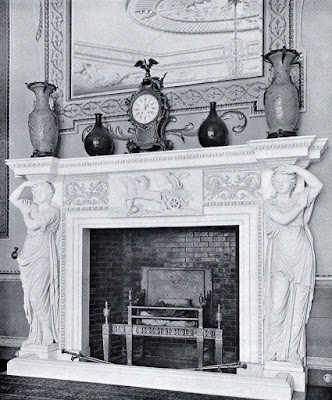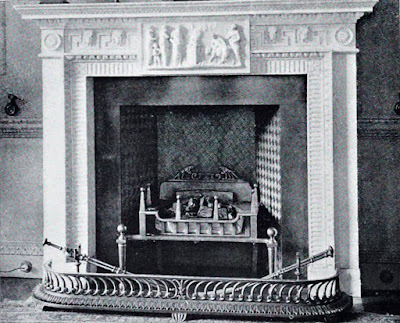 |
| Hatchlands Park © A Knowles (2014) |
 |
| Hatchlands Park - side view © R Knowles (2019) |
In 1749, Hatchlands Park was bought by Admiral Edward Boscawen, younger son of the 1st Viscount Falmouth, and his wife, Frances, daughter of William Evelyn Glanville of St Clair, Kent, and great niece of the diarist John Evelyn. Frances Boscawen later became one of the leading bluestocking hostesses, holding literary salons at her home in South Audley Street.
Having lived in the old Tudor house for some years, the Admiral commissioned a new house in c1756. The exterior was designed in the Palladian style by Stiff Leadbetter, Surveyor to St Paul’s, whilst the interiors were designed in a more Neoclassical style by Robert Adam. This is some of Adam’s earliest work and shows what his designs were like when he first returned from his Grand Tour. Designed around a nautical theme including sea nymphs, anchors, dolphins, cannons and Neptune, the decorations were originally white. Hatchlands boasts a number of beautiful Adam ceilings, friezes and fireplaces, but the work remained unfinished on the Admiral’s death in 1761.
Humphry Repton at Hatchlands
Having lived in the old Tudor house for some years, the Admiral commissioned a new house in c1756. The exterior was designed in the Palladian style by Stiff Leadbetter, Surveyor to St Paul’s, whilst the interiors were designed in a more Neoclassical style by Robert Adam. This is some of Adam’s earliest work and shows what his designs were like when he first returned from his Grand Tour. Designed around a nautical theme including sea nymphs, anchors, dolphins, cannons and Neptune, the decorations were originally white. Hatchlands boasts a number of beautiful Adam ceilings, friezes and fireplaces, but the work remained unfinished on the Admiral’s death in 1761.
 |
| Ceiling of the bay window in the Saloon, Hatchlands from The architecture of Robert and James Adam by AT Bolton (1922) |
William Brightwell Sumner bought Hatchlands in 1770, having made his fortune in the East India Company. His son, George Holme Sumner, commissioned Humphry Repton to redesign the grounds and one of Repton’s famous Red Books detailing his plans, most of which were executed, survives. A facsimile copy of the Red Book is on display in the Drawing Room.
 |
| Gravel walk leading to Garden Entrance, Hatchlands © R Knowles (2019) |
Sumner commissioned Joseph Bonami to alter several rooms, including the Garden Hall – the entrance hall for visitors today.
Later history
The house was sold to Lord Rendel in 1889. His alterations included: a new entrance on the east side of the house; a new dining room; the redecoration of the Staircase Hall; the Music Room, designed by Sir Reginald Blomfield; and the gilding and colouring of Adam’s plasterwork.
Lord Rendel’s grandson, Harry Stuart Goodhart-Rendel, gave the house to the National Trust in 1945.
Since 1987, Hatchlands has been the family home of Alec Cobbe and the display setting for his fantastic collection of Old Masters and historic keyboard instruments, including the ‘library table’ piano used by Bizet to compose Carmen.
 |
| The Stables, Hatchlands © A Knowles (2014) |
As Hatchlands is a family home, no internal photographs are allowed, but I have found some old photographs in a book about Adam's work.
Garden Hall
This was the main entrance until Lord Rendell created a new entrance on the east side of the house. The Garden Hall is the work of Joseph Bonomi and dates to about 1800.
 |
| Garden Entrance, Hatchlands © A Knowles (2014) |
The Drawing Room
There is an Adam frieze and fireplace in this room. The original Adam ceiling collapsed c1860 and was replaced using one of the two Adam designs for this ceiling from John Soane’s Museum. Some of the fragments of the original ceiling are on display in the Second-hand Bookshop.
 |
| Fragments from the original Drawing Room ceiling at Hatchlands On display in the Second-hand Bookshop |
This room has my favourite portraits in the house on display – Admiral the Honourable Edward Boscawen by Sir Joshua Reynolds (on loan from the National Portrait Gallery); Queen Charlotte by Sir Joshua Reynolds; George IV by Sir Thomas Lawrence; and a self-portrait of Angelica Kauffman.
Note the bust of Marie Antoinette on the mantelpiece which looks down on her pianoforte.
There is also a painting of Catherine Cobb (1761-1839), a Woman of the Bedchamber to Queen Caroline, by Jean-Laurent Mosnier.
 |
| Adam fireplace in the Drawing Room, Hatchlands from The architecture of Robert and James Adam by AT Bolton (1922) |
The Saloon
 |
| The Saloon, Hatchlands from The architecture of Robert and James Adam by AT Bolton (1922) |
 |
| The fireplace in the Saloon, Hatchlands from The architecture of Robert and James Adam by AT Bolton (1922) |
 |
| Part of the ceiling in the Saloon, Hatchlands from The architecture of Robert and James Adam by AT Bolton (1922) |
 |
| The Library, Hatchlands from The architecture of Robert and James Adam by AT Bolton (1922) |
 |
| Fireplace in the Library, Hatchlands from The architecture of Robert and James Adam by AT Bolton (1922) |
 |
| Part of ceiling in the Library, Hatchlands from The architecture of Robert and James Adam by AT Bolton (1922) Note the empty roundels which have since been filled. |
The Dining Room
This room, and part of the entrance hall, were originally Admiral Boscawen’s bedroom and dressing room. Most of the Adam ceiling from the bedroom was reused.
The decoration in this room was incomplete and is now based on a late 18th century design by Girard for Carlton House.
The Staircase Hall
 |
| Fireplace in the Dining Room, Hatchlands from The architecture of Robert and James Adam by AT Bolton (1922) |
The large, flower-shaped classical ornaments and compartments are attributed to Adam. Lord Rendel added the plaster ribbons, swags and cameos.
Music Room
 |
| First Floor Landing, Hatchlands from The architecture of Robert and James Adam by AT Bolton (1922) |
This room contains portrait prints of composers and musicians.
Last visited May 2019
Bolton, Arthur T, The architecture of Robert and James Adam (1758-1794) (1922)
The Cobbe Collection Trust in association with The National Trust, Hatchlands Park (2002)

No comments:
Post a Comment